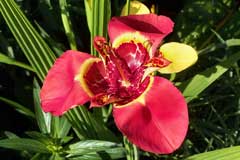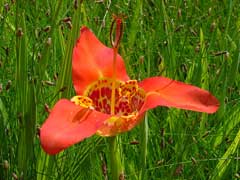 |
|
http://de.wikipedia.org/wiki/Benutzer:Lorbeer |
 |
| http://commons.wikimedia.org/wiki/User:NoahElhardt |
Translate this page:
Summary
Physical Characteristics

 Tigridia pavonia is a CORM growing to 0.6 m (2ft) by 0.1 m (0ft 4in).
Tigridia pavonia is a CORM growing to 0.6 m (2ft) by 0.1 m (0ft 4in).
See above for USDA hardiness. It is hardy to UK zone 8 and is not frost tender. It is in flower from June to October, and the seeds ripen from September to October. The species is hermaphrodite (has both male and female organs) and is pollinated by Insects.
Suitable for: light (sandy) and medium (loamy) soils and prefers well-drained soil. Suitable pH: mildly acid, neutral and basic (mildly alkaline) soils. It cannot grow in the shade. It prefers dry or moist soil.
UK Hardiness Map
US Hardiness Map
Synonyms
Plant Habitats
Cultivated Beds;
Edible Uses
Edible Parts: Root
Edible Uses:
Corm - cooked[2, 46, 61, 105]. Delicious when baked, tasting like a sweet potato[K]. The corm is quite small unfortunately and so will never be more than a very tasty occasional treat[K]. The corm has an unpleasant, burning sensation on the mouth if it is eaten raw[K].
References More on Edible Uses
Medicinal Uses
Plants For A Future can not take any responsibility for any adverse effects from the use of plants. Always seek advice from a professional before using a plant medicinally.
Infertility
The plant has been used to promote fertility[200].
References More on Medicinal Uses
The Bookshop: Edible Plant Books
Our Latest books on Perennial Plants For Food Forests and Permaculture Gardens in paperback or digital formats.

Edible Tropical Plants
Food Forest Plants for Hotter Conditions: 250+ Plants For Tropical Food Forests & Permaculture Gardens.
More

Edible Temperate Plants
Plants for Your Food Forest: 500 Plants for Temperate Food Forests & Permaculture Gardens.
More

More Books
PFAF have eight books available in paperback and digital formats. Browse the shop for more information.
Shop Now
Other Uses
References More on Other Uses
Cultivation details
Prefers a well-drained light sandy soil in a warm sunny position[1, 42]. Likes plenty of moisture in the growing season[188]. Corms are not hardy outside the milder areas of Britain and should be dug up in the autumn and stored in a cool but frost free place over winter[1]. Plant out the corms in April or May about 15cm deep[79]. In areas with cool summers the plant might not manage to develop adequate corms for subsequent growing[200]. A beautiful, late flowering corm, it self-sows freely with us on a well-drained soil in Cornwall, even very wet winters do not seem to affect this plant[K]. Plants flower in their first or second year from seed[K].
References Carbon Farming Information and Carbon Sequestration Information
Temperature Converter
Type a value in the Celsius field to convert the value to Fahrenheit:
Fahrenheit:
The PFAF Bookshop
Plants For A Future have a number of books available in paperback and digital form. Book titles include Edible Plants, Edible Perennials, Edible Trees,Edible Shrubs, Woodland Gardening, and Temperate Food Forest Plants. Our new book is Food Forest Plants For Hotter Conditions (Tropical and Sub-Tropical).
Shop Now
Plant Propagation
Seed - sow early spring in a greenhouse. It usually germinates freely. When they are large enough to handle, prick the seedlings out into individual pots and grow them on in the greenhouse for their first winter. Plant them out into their permanent positions in late spring, after the last expected frosts. If the seedlings are potted up whilst still small and grown on quickly, they sometimes flower in their first year[K]. Division of offsets in the autumn. Store the corms in a cool but frost-free place and plant them out in the late spring. It is probably best to pot up the smaller corms and grow them on in a greenhouse for a year before planting them out in the spring.
Other Names
If available other names are mentioned here
Native Range
NORTHERN AMERICA: Mexico (Chihuahua, Durango, Nuevo León, San Luis Potosí, Sinaloa, Sonora, Tamaulipas, Zacatecas, Chiapas, Guanajuato, Guerrero, Hidalgo, México, Michoacán de Ocampo, Morelos, Nayarit, Oaxaca, Puebla, Querétaro, Veracruz de Ignacio de la Llave, Ciudad de México) SOUTHERN AMERICA: Guatemala, Honduras, El Salvador
Weed Potential
Right plant wrong place. We are currently updating this section.
Please note that a plant may be invasive in one area but may not in your area so it's worth checking.
Conservation Status
IUCN Red List of Threatened Plants Status :

Growth: S = slow M = medium F = fast. Soil: L = light (sandy) M = medium H = heavy (clay). pH: A = acid N = neutral B = basic (alkaline). Shade: F = full shade S = semi-shade N = no shade. Moisture: D = dry M = Moist We = wet Wa = water.
Now available:
Food Forest Plants for Mediterranean Conditions
350+ Perennial Plants For Mediterranean and Drier Food Forests and Permaculture Gardens.
[Paperback and eBook]
This is the third in Plants For A Future's series of plant guides for food forests tailored to
specific climate zones. Following volumes on temperate and tropical ecosystems, this book focuses
on species suited to Mediterranean conditions—regions with hot, dry summers and cool, wet winters,
often facing the added challenge of climate change.
Read More
Expert comment
Author
(L.f.)DC.
Botanical References
200
Links / References
For a list of references used on this page please go here
Readers comment
| Add a comment |
|
If you have important information about this plant that may help other users please add a comment or link below. Only comments or links that are felt to be directly relevant to a plant will be included. If you think a comment/link or information contained on this page is inaccurate or misleading we would welcome your feedback at [email protected]. If you have questions about a plant please use the Forum on this website as we do not have the resources to answer questions ourselves.
* Please note: the comments by website users are not necessarily those held by PFAF and may give misleading or inaccurate information.
To leave a comment please Register or login here All comments need to be approved so will not appear immediately.
|
Subject : Tigridia pavonia
|
|
|
|